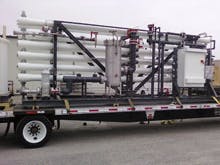In Wisconsin, a large food processor packages green beans, carrots and potatoes. As part of both a green initiative to improve its processing methods and an energy saving measure, the plant was considering alternatives to the softeners they used to treat boiler makeup water and canning water. The plant’s feedwater is derived from a high-capacity well installed and maintained by Layne Christensen Co. , and Layne was contacted to suggest possible improvements.
Through RO, the alkalinity and TDS levels in the boiler are now reduced by at least 95%, which will allow the boiler to operate with less than 2% blowdown as a percentage of makeup water flow. This will save the processor both energy and boiler chemicals.
As an added benefit, the plant now enjoys a tremendous reduction in salt consumption and, therefore, reduced chlorides in the plant’s discharge. Layne’s projections anticipate a 97.7% reduction in salt consumption, which is expected to translate to a reduction of over 235 tons annually. While the plant will continue to use its softeners to reduce hardness, they will be softening RO water, not well water, and it is expected that they will only need to regenerate every 16 days, as opposed to the previous regeneration every eight hours.
While the initial target of the project was boiler makeup water, the scope of the project was expanded. Now, other areas of the plant benefit from the high-quality RO water, which is used in the food processing lines, and in the canning operation as topping water.


